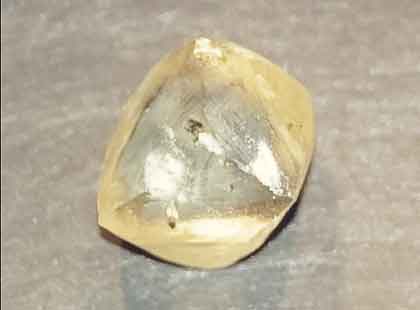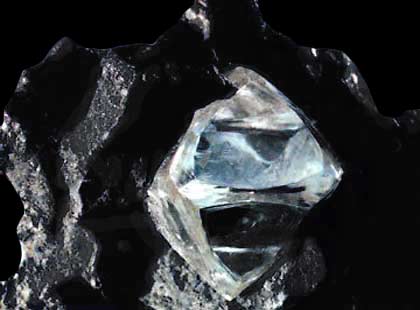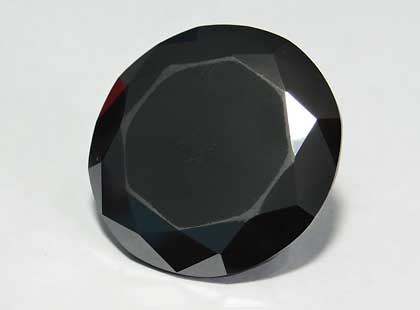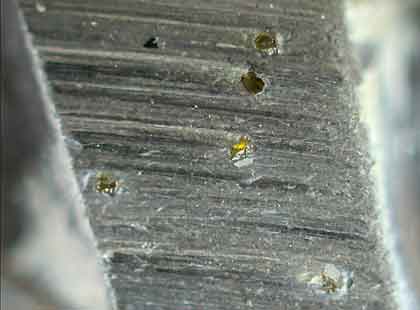Birthstones by the Month
The April Birthstone is Diamond
Diamond in the Rough
The April birthstone is Diamond. Diamond is well known as a material with exceptional physical qualities, most of which are derived from the strong covalent bonding between its carbon atoms. Diamond also has relatively high optical dispersion which is attributed to its ability to disperse light of many different colors.
The birthstone for April is named Diamond an in ancient Greek it means “unalterable" or "unbreakable".
Diamond popularity has risen since the 19th century because of improved cutting and polishing methods and growth in the world economy.
A number of large or astonishing diamonds have gained distinction, both as superb examples of the striking nature of diamonds and because of the illustrious people who wore, bought, and sold them.
Diamond Facts
Considered to be the hardest natural substance found on Earth, Diamonds are valued for their beauty in jewelry and their uses in modern technology. Diamonds are the only 10 on the Mohs hardness scale, making them ideal as cutting and polishing tools.
Diamonds are considered “fireproof” as they need an exceptional amount of heat (about 1292 degrees Fahrenheit) to actually burn. This hardy gemstone also has the greatest thermal conductivity causing a Diamond to always feel cool to the touch, earning Diamonds the nickname “ice".
Diamonds have also been called a girl’s best friend, as was made popular by the Marilyn Monroe version of the 1940’s song originally written for the Broadway production of Gentlemen Prefer Blondes.
The characteristics of Diamond
Diamonds occur naturally in a wide range of primary colors. The most common varieties are yellow and brown, while the rarest are blue and red. The most widely used and desired for jewelry however, continues to be the crystal clear versions.

Brilliant Cut Diamonds
Diamonds in modern brilliant cut showing the relatively high optical dispersion (ability to disperse light of different colors). [3]
Cut and Clarity of Diamond the April birthstone
Most commonly, Diamonds are cut to be able to produce two round diamonds with the least amount of crystal lost. Round and princess are the most popular cuts due to their increased light refraction resulting in superior sparkle. Other diamond cuts commonly seen in jewelry include pear, cushion, oval, emerald, marquise, asscher, radiant and heart.
The value of Diamond
Diamonds have historically been used as a means to display, store and transport wealth. Since Diamonds are so hardy, they are easy to pass along through generations including during times of persecution.
Diamonds have come to be associated with wealth and emotional connotations of steadfast commitment, purity, rarity and everlasting love. Cost is also often associated with scarcity of gem-quality Diamond materials and the lengthy process in which it is mined and refined by multiple sources.
Is Diamond ever treated?
Diamonds can be treated in a number of ways to improve the color or clarity. Laser drilling is used to remove black carbon inclusions.
Since Diamonds have a unique refractive index, common practices of wax or oiled treatments are not effective and fracture filling is the preferred method for reducing the appearance of small internal cracks. Color treatments for improving vibrancy include irradiation and annealing.
Some Diamonds are also subjected to high-pressure and high-temperature treatments in order to lighten the color.

The Oppenheimer Diamond
The Oppenheimer Diamond is one of the biggest uncut diamonds. A nearly perfectly formed yellow diamond crystal weighing about 253.7 carats. It measures approximately 20 × 20 millimeters. [5]
More about Diamond the April birthstone
The largest rough diamond was found in 1905 and weighs 2.8 pounds or 3,106 carats.
Found throughout history, until the 18th Century, the only Diamond mines were found in India. As this source began to decrease, Diamonds were discovered in South America and later in North America.
These discoveries paled in comparison to the mines found in Africa. Despite the Great Diamond Rush in Africa, Russia continues to produce the most diamonds by volume while Botswana produces the highest quality.
While North America produces little to no diamonds itself, the U.S. buys more than 40% of the world’s high-quality Diamonds in order to produce the world’s largest diamond jewelry market.
The American Gem Society's April Birthstone page has more information to help you buy from knowledgeable and skilled jewelers and to help you make the most informed buying decision.
Image Attribution
- By Unknown USGS employee [Public domain] via Wikimedia Commons
- By Trishtha (Own work) [CC BY-SA 4.0], via Wikimedia Commons
- By Mario Sarto (Self-photographed) [GFDL or CC-BY-SA-3.0], via Wikimedia Commons
- By Hustvedt (Own work) [CC BY-SA 3.0 or GFDL], via Wikimedia Commons
- By Eurico Zimbres FGEL/UERJ (Own work) [CC BY-SA 2.0 br], via Wikimedia Commons


